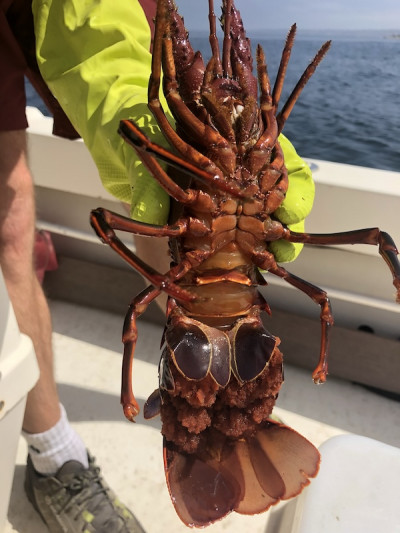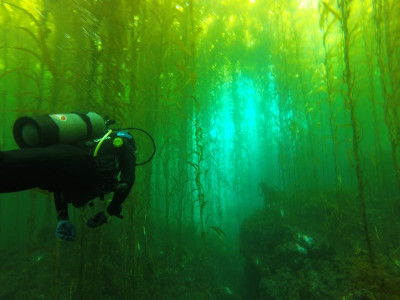This is the fourth in a yearlong series of stories showcasing the research that the Ocean Protection Council supported in partnership with California Sea Grant, with funding from Proposition 84.
For decades, the general wisdom has been that the California spiny lobster — a clawless crustacean that lives in rocky reefs from Santa Barbara to Baja California, Mexico — did not face overfishing pressures. But when San Diego State University (SDSU) biologist Kevin Hovel began to examine the published research, he realized fisheries managers didn’t have the information they needed to be sure.

“I think the assessment is a little premature,” he says. Given that spiny lobster constitutes the third-most valuable fishery in California and the annual catch can fluctuate substantially, more clarity seemed worthwhile.
Hovel has studied this species for decades but was focused on behavioral ecology — “the way they move, what they eat, how they interact with predators, all those kinds of things,” he says. Recently, in a project supported by California Sea Grant and the California Ocean Protection Council and funded by Proposition 84, Hovel has turned to the variables that influence spiny lobster populations.
“Most of the information that the state of California uses to model the spiny lobster’s population and plan its management — nearly all of it, really — comes from the commercial fishery,” Hovel says. The data, then, is mostly a count of how many lobsters are pulled out of the water. This does not account for the many variables that could influence the catch, such as changes to the local, national or even international economy, which can influence how many people even bother to harvest lobsters. Nor does it consider the lobsters that live south of the international border, in Mexico.
A more accurate population model needs to start with a better understanding of the species’ fertility. How old and big are lobsters when they first reproduce? How many eggs can a female produce? Do these numbers hold steady across the thousands of kilometers in latitude where lobsters live?
“Each of these is a fundamental question we needed to answer,” says Robert Dunn, a postdoctoral researcher who collaborated with Hovel. Until recently, our best answers came from studies conducted before 1955 that examined less than 30 lobsters in total. The seventy years of subsequent harvest had no doubt altered lobster biology; the establishment of state marine protected areas, by altering the geography of that harvest, presumably had an impact, too.
Then there’s the fact that the original study never considered whether fecundity varied across the lobster’s range. Today, many academics and fishers believe that there are two separate populations of spiny lobsters, one at the northern end of the species range and one to the south, with potentially different reproductive biology. Nonetheless, within California, the fishery is currently managed as one stock, so the same rules and regulations apply across all of the state’s waters.
Expanding the picture
Hovel, Dunn and their team set out to collect the data needed to clarify the regional differences. They focused not only on California waters but included the coast of Baja California, Mexico, where spiny lobsters are also a major fishery species, and from where lobster larvae might be carried by ocean currents to California.

The team included academics and students from SDSU and from Baja California, Mexico; as well as lobster harvesters from both countries, who contributed their deep knowledge of the crustaceans along with their vessels to set traps.
“Given the geographic scope and bi-national nature of this project, it really would not have been possible without such a large team of collaborators,” Dunn says.
The researchers built special traps with a smaller mesh than their commercial counterparts. This allowed them to capture juvenile lobsters, which are illegal to harvest commercially but essential for science. After two years, the team had collected and measured 6,500 lobsters. The researchers also counted and measured the eggs on 130 female lobsters — each of which can hold hundreds of thousands of eggs.
The new data showed the lobsters were maturing at much younger ages and smaller sizes than the existing models suggested. That could be read as good news: the lobsters have more time than we knew to reproduce before they’re harvested. But it could also signal a concerning trend, Hovel says.
“Because we’re pulling larger individuals out of the population, there’s an artificial selection for smaller individuals to reproduce and mature. That’s not healthy.” Indeed, it could be a signal of overfishing, he says.
Regional differences

To dig into the genetic variation of the species, the research team analyzed 600 samples of leg tissue from lobsters across eight sites. While there was little genetic differentiation between individuals from San Diego and Santa Barbara, individuals from Bahia Tortugas in Mexico — approximately 600 miles south of San Diego — showed genetic differentiation. This suggests that some populations may be more isolated than others along the North American coastline, and is an area that Hovel says needs further study.
Even within California, there are clear physical differences between the state’s spiny lobster populations. Northern California lobsters are larger on average than southern lobsters and produce more eggs. In southern California, closer to San Diego, once a lobster starts reproducing, its fecundity holds fairly steady throughout its lifetime.
“But the curve is much steeper in the northern areas,” Hovel says. “As lobsters get larger, their reproductive value goes up.”
All told, Hovel says, the studies reveal enough variation that fisheries managers should take note — especially given the increased pressures of climate change. The simple story we once told about spiny lobsters, then, has turned out to be not so simple.